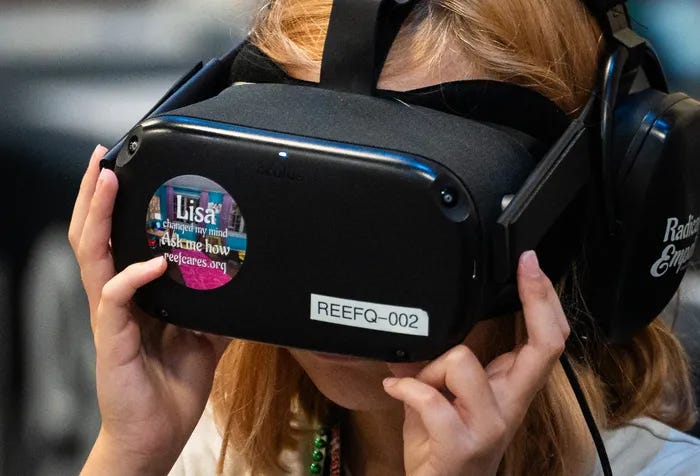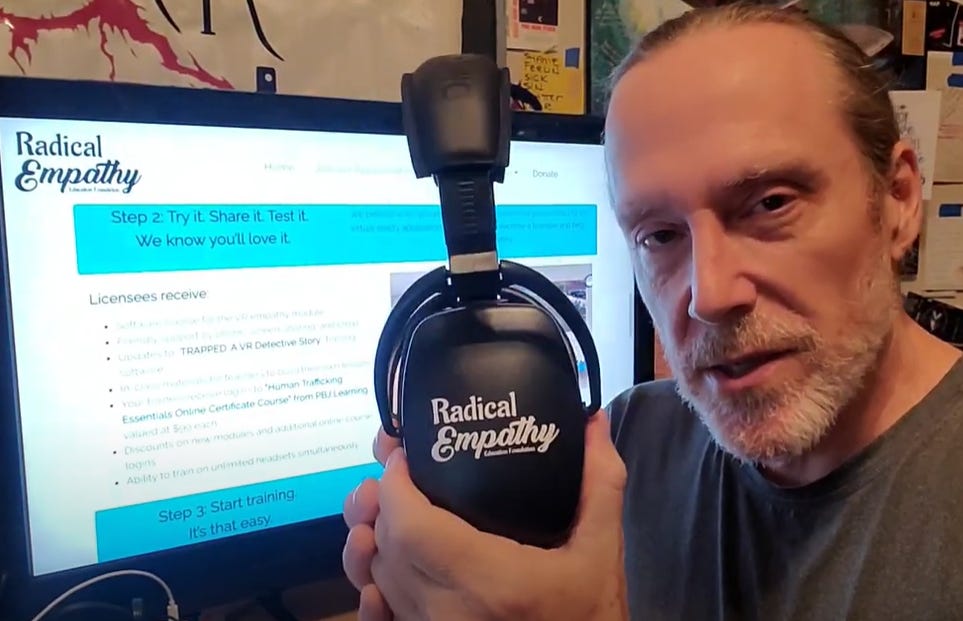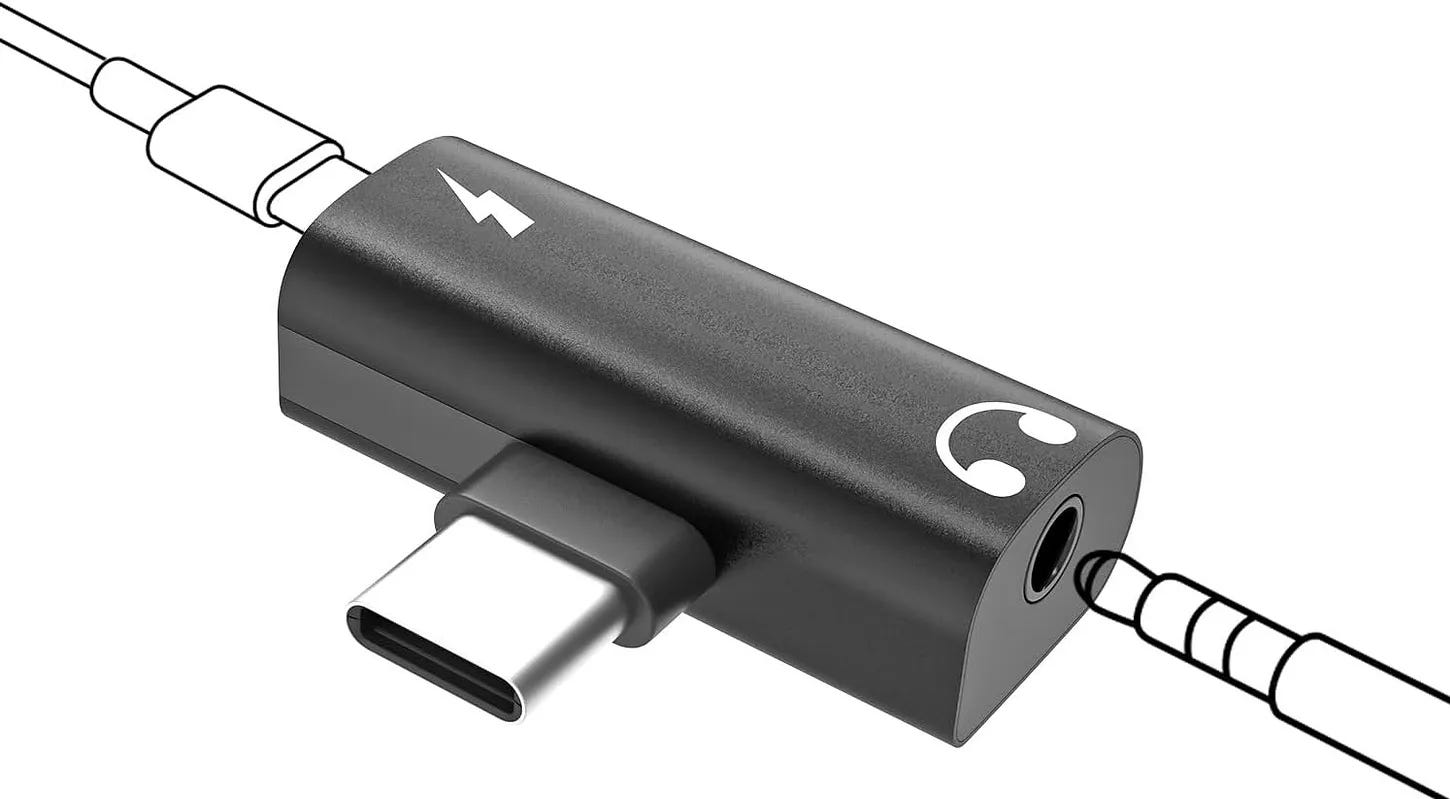Why the Meta Quest 3 (Not the 3S) is the Best Choice for VR Training
Avoid Audio Headaches and Charging Hassles—Why Trainers Should Stick with the Quest 3 (and why the extra bucks are worth it!)
When investing in VR hardware for training, it’s easy to focus on specifications like resolution and processing power. However, ease of use in real-world training environments is just as critical—if not more so—especially when managing multiple headsets and users. While the newly released Meta Quest 3S may seem like an attractive option, one major design flaw makes it a poor choice for professional training setups: the lack of a dedicated 3.5mm headphone jack.
For trainers who need reliable, hassle-free hardware, the Meta Quest 3 remains the best choice. Here’s why:
How Our VR Training Works: Real-World Challenges Trainers Face
Our licensees typically manage five or more headsets at each event, constantly rotating users through immersive VR training sessions. This means trainers must:
Quickly put on and remove headsets and headphones for new participants.
Maintain headset charge levels throughout long training days (8-12 hours).
Ensure every user experiences high-quality, immersive sound to maximize learning.
With training groups moving participants through VR sessions at a fast pace, simplicity and reliability are paramount. Trainers don’t have time for pairing issues, extra adapters, or unnecessary troubleshooting—which is exactly what the Quest 3S introduces by eliminating the headphone jack.
The Importance of Headphones in VR Training
Sound isolation is critical for VR training. Background noise can break immersion and distract trainees, reducing the effectiveness of the experience. Using proper over-ear headphones is the best way to:
Enhance immersion by blocking out external sounds.
Ensure clear, distraction-free audio, so trainees absorb every detail.
Keep the experience consistent across all users.

We strongly discourage using in-ear headphones or earbuds (including AirPods) for VR training. Here’s why:
Poor noise isolation – External distractions reduce training effectiveness.
Uncomfortable for long sessions – In-ear headphones may cause discomfort over time.
High hygiene concerns – They accumulate earwax and bacteria, requiring frequent cleaning.
More likely to fall out – This disrupts training and requires constant readjustment.
For the best results, we recommend the Direct Sound EX29 Plus Extreme Isolation Headphones. These over-ear headphones are built for professional use, offering excellent durability, comfort, and noise isolation. Radical Empathy even has custom-branded versions specifically designed for our training programs.

Why the Quest 3S’s Lack of a Headphone Jack Is a Dealbreaker for Professional Training
While the Quest 3S may be positioned as a budget-friendly option, it introduces major usability issues for professional trainers. The most significant? No 3.5mm headphone jack.
Instead, Quest 3S users must rely on:
Bluetooth headphones – Pairing and managing multiple Bluetooth devices across five or more headsets is an absolute nightmare in a fast-paced training environment.
USB-C passthrough or splitters – If trainers want to use wired headphones while keeping the headsets charging, they need additional adapters, which are impractical and introduce another point of failure.
With the Quest 3, trainers can simply plug in wired over-ear headphones and get started—no pairing, no adapters, no troubleshooting.
The Nightmare of Bluetooth Headphones in a Training Environment
At first glance, using Bluetooth headphones may seem like a viable alternative. However, any trainer who has ever managed multiple headsets will tell you otherwise. Here’s why:
Pairing issues – Bluetooth devices sometimes struggle to connect properly, causing frustrating delays.
Latency problems – Even minor audio lag can break immersion and disrupt the learning experience. In virtual reality settings, lag can cause nausea.
Accidental cross-pairing – Headphones can unintentionally connect to the wrong headset, leading to unnecessary confusion.
Battery management – Trainers would have to keep two devices charged per user (both the headset and the headphones).
Simply put, Bluetooth is too unreliable and complicated for professional training with multiple headsets. Wired headphones are the only practical solution, and the Quest 3 makes them easy to use.

Charging While Using Audio: A Crucial Factor
Trainers need to keep headsets charging constantly to ensure smooth operation throughout the day. With the Quest 3S, trainers face a major problem: there is only one USB-C port. This means that to charge the headset while using wired headphones, trainers must use a USB-C splitter—an unwieldy, unnecessary extra step.

The Quest 3, with its dedicated 3.5mm headphone jack, allows trainers to charge and use headphones simultaneously with zero hassle.
Other Advantages of the Meta Quest 3
Beyond the crucial audio and charging considerations, the Quest 3 is simply a better headset overall for training programs:
Higher-resolution display – Provides a clearer, more immersive experience.
Better optics – Reduces motion blur and improves visual clarity.
More practical design – Built for ease of use in professional settings.
Conclusion: The Meta Quest 3 Is the Smart Choice
For professional trainers, reliability, simplicity, and ease of use are non-negotiable. The Meta Quest 3 is the clear winner because it:
✅ Includes a 3.5mm headphone jack – No need for adapters or Bluetooth pairing headaches.
✅ Allows simultaneous charging and audio use – Unlike the Quest 3S.
✅ Supports high-quality over-ear headphones without an adapter – Essential for immersion and clarity.
✅ Eliminates unnecessary complexity – Trainers can focus on delivering impactful training, not troubleshooting hardware.
✅ Avoids hygiene issues – Over-ear headphones are cleaner and more durable than in-ear options.
While the Quest 3S may seem like a budget-friendly choice, the hidden costs of inconvenience and inefficiency make it a poor option for professional training environments. If you’re serious about running smooth, effective VR training, stick with the Quest 3 and invest in proper over-ear headphones.
To learn more about our training solutions and recommended hardware, visit Radical Empathy Education Foundation.
Radical Empathy’s Recommendations for VR Training Devices
When providing training with VR headsets, you want a frustration-free experience for both users and trainers. With our app, trainees simply put on the headset and headphones, complete the interactive experience, and remove the gear—seamlessly. But to make that happen, every part of the system must work together.
Hard truth: VR hardware is always evolving, and so do our recommendations. Here’s what we suggest right now for the best experience (as of May 2025).
Great news: we can source all of these items for you through our “provisioning partners” so you don’t have to worry about anything. We’re just walking you through our mindset here so you understand what work we’ve done to prepare this list for you. You tell us how many headsets you want, and we’ll get you a price. The provisioning partner will install everything, ship your outfitted headsets (and more) to you, ready to go! And to make it even easier for you, they will be your customer service for any hardware or warranty issues.
Quest 3 Headset (base hardware, prior to upgrades) (link)
The Meta Quest 3 is our default recommendation for VR training. This blog explains why we prefer it over the Quest 3S, but in short: it’s more powerful, more flexible, and better suited to high-volume training environments.
This is the most current pricing page from Meta.
Needed Commercial Training Upgrades
PU Leather Facial Interface for Quest 3 (Q3FC1) (link)
This is a must for keeping the headset sanitary. These PU leather interfaces are easy to clean, don’t absorb sweat or makeup, and are far sturdier than the factory default. Expect to replace these at least annually, depending on use.
BINBOK VR T3S Plus Head Strap for Quest 3/3S (link)
Why we love it:
The stock head strap is uncomfortable, hard to adjust, and comes with a meager 2.5-hour battery.
This upgrade solves both problems with enhanced comfort, quick adjustability, and a HOT-SWAP battery system.
🔧 Adjustable Support Arms
180° movement with an easy rear knob for quick resizing—great for children, adults, and glasses-wearers.
🔋 Battery System
Two 8000mAh magnetic batteries. Swap them out during the day to extend headset usage by 6+ hours—no wall plugs required.
💡 Important
This kit does not include a USB-C charger. You'll need to purchase a compatible one separately. This one is compatible (link to USB-C charger).
EX29 Plus v3.0 Extreme Isolation Headphone Midnight Black (link)
Training in a noisy room? These over-ear isolation headphones block out distractions and ensure your trainees stay fully immersed.
Sanitary Items (beyond hardware)
These aren’t just “nice to have”—they’re required for hygiene and professionalism. You can choose any similar products.
Alcohol Wipes for Facial Interfaces (link)
Care Touch Alcohol Wipes (70% Isopropyl, individually wrapped, 400 count).
Microfiber Cloths for Lens Cleaning (No Alcohol!) (link)
Use only dry microfiber cloths on headset lenses to avoid damage.
Travel / Storage / Charging Items (beyond VR hardware)
Every team has unique needs. Whether you're managing 2 headsets or 200, we’ve got recommendations for:
Storage cases
Fleet chargers
Cable organization
Charging management during travel
Want a custom solution? Contact us!
About Beyond the Red Flags
Billy Joe and Jacqueline Cain are the passionate founders of Radical Empathy Education Foundation. Together, they are on a mission to educate the world about emotional abuse and abuse prevention through immersive experiences like TRAPPED: A VR Detective Story. Their goal is to empower individuals to recognize, prevent, and respond to these issues, saving lives along the way.
If you believe in this mission, you can support their work through Buy me a coffee or a donation to Radical Empathy Education Foundation.
About TRAPPED: A VR Detective Story
TRAPPED: A VR Detective Story provides users with an immersive, interactive experience that tells the story of Lisa, a 14-year-old trafficking victim. Through Lisa’s narrative, participants gain insight into the subtle yet powerful tactics predators use to manipulate and control their victims. This engaging VR experience has already reached over 15,000 participants across 10 states, serving as a critical resource for abuse prevention in schools, shelters, law enforcement, and corporations.

About Radical Empathy Education Foundation
Radical Empathy Education Foundation is a nonprofit organization dedicated to preventing abuse and human trafficking through innovative, immersive VR technology. Their award-winning training tools educate users on the tactics predators use and empower individuals to recognize and avoid abusive situations.
Learn more about Radical Empathy Education Foundation and connect to access their VR training at ArborXR’s XR Directory.









We have been monitoring the tariff situation.
This is the latest.
https://www.theverge.com/news/664811/us-china-pause-tariffs-90-days